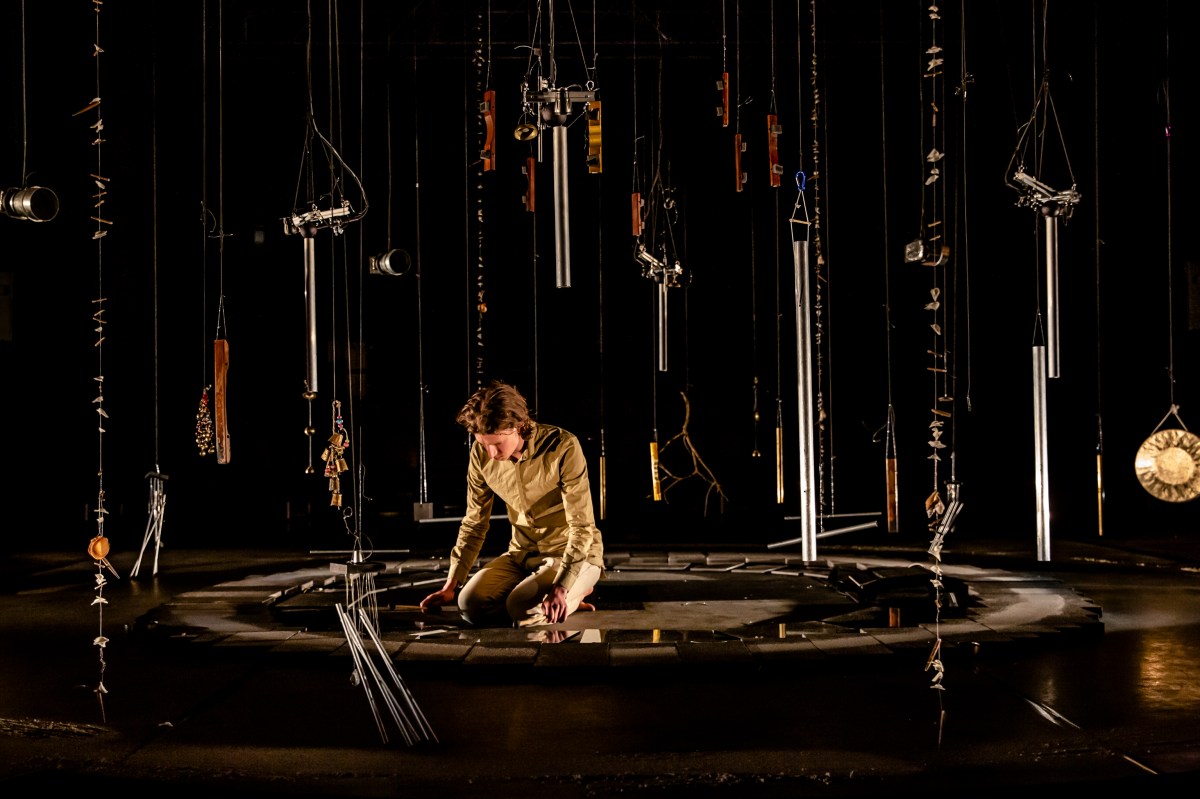Everywhen was a solo performance by Melbourne-based composer and percussionist Matthias Schack-Arnott. Essentially, it was a kind of sonic and visual meditation or mandala, involving a rotating structure of concentric circles like a kind of musical Hills Hoist or Alexander Calder mobile that hung from the lighting grid, from which a collection of roughly 100 sound objects – ranging from cymbals, chimes, bells and marimba keys to found objects like branches, bunches of dried seeds and strings of shells – were suspended on counterweighted strings.
While the structure rotated, Schack-Arnott walked on his own narrow circular path between the objects – either in the same or the opposite direction – while raising or lowering them using the counterweights so that they scraped along the floor, which had variously corrugated, smooth or tiled surfaces that were also arranged in concentric circles.
Whenever the structure briefly paused and came to rest, he detached some of the objects from the strings, entered the inner circle – like the inner shrine of a Buddhist temple – and arranged them on the floor, where he scraped them or played them with sticks more rhythmically and intricately, as well as ‘playing’ the tiles on the floor, and striking the objects still hanging on the structure when it resumed its rotation around him. Objects also swung and collided with each other, and the strings of shells vibrated and shook, almost as if they had minds of their own.
This one-person percussion orchestra was augmented by small shotgun mics, which were placed on the floor around the mandala, as was pointed out to me afterwards by a helpful venue technician and further explained by a knowledgeable colleague. These crucially picked up harmonics and overtones and fed them back to a sound desk behind the audience, where they were remixed and fed back into the auditorium, generating an ambient soundscape of shifting tones and textures that sometimes resembled the music of the spheres, and at one point sounded like rain.
Finally, the entire apparatus was side-lit by theatre lights on tree-stands, so that the surfaces and shapes of the objects as they moved – especially the metallic instruments – serendipitously refracted and changed the overall lighting state as it subtly faded up and down. This visual effect, as well as the overall sense of a revolving microcosm, also echoed the Festival theme of djinda (stars).
Read: Circus review: The Wet, Cairns Performing Arts Centre
Everywhen was a deeply meditative work of sound art, visual art and contemporary performance. It was also a work of haunting beauty and – in its own way – absorbing drama. Schack-Arnott’s state of relaxed yet heightened attention – which was essential for him to effectively navigate and become part of the work – inspired a similar state in the audience as we watched, listened and noticed things. Fifty minutes flew past, and I left the theatre in silence and at peace with the universe.
Everywhen
Presented in association with Perth Institute of Contemporary Arts
Concept, composer and performer: Matthias Schack-Arnott
Sound designer and collaborator: Tilman Robinson Robotics
Speaker construction and collaborator: Nick Roux
Lighting designer and technical director: Keith Tucker
Producer: Michaela Coventry (Sage Arts)
Everywhen was performed from 21-25 February as part of Perth Festival.





